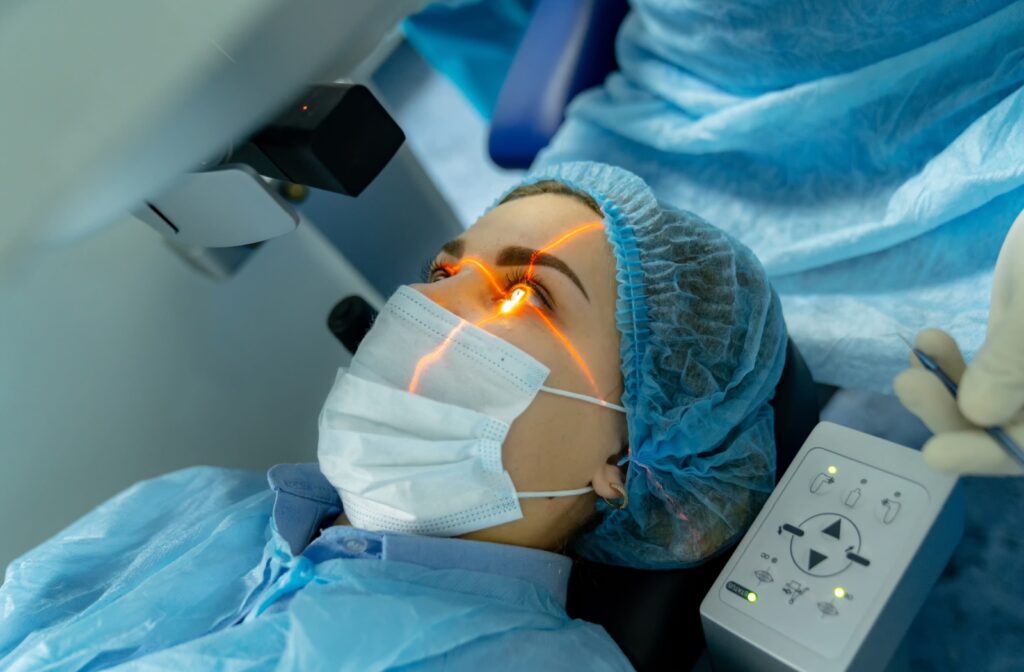Laser eye surgery is an attractive option for improving vision, as it offers a long-term solution for vision correction. As with every procedure, however, there are a few factors to consider.
Fortunately, laser eye surgeries like LASIK and PRK offer promising solutions for vision improvement, as they can correct a range of refractive errors, including mild to severe astigmatism.
Your eye doctor can help determine if you’re a candidate for laser eye surgery.
Understanding Laser Eye Surgery
Laser eye surgery is a medical procedure that uses a laser to reshape the cornea. This corneal reshaping changes how light enters the eye, correctly focusing light on the retina, thereby improving vision. The result is clearer, sharper vision without the need for glasses or contact lenses.
There are two common types of laser eye surgery: LASIK and PRK. Both surgeries are highly regarded for their significant ability to improve vision, but they differ in their techniques and recovery process.
LASIK (Laser-Assisted In Situ Keratomileusis) involves creating a thin flap in the cornea, which is lifted to allow the laser to reshape the underlying tissue. This flap is then repositioned, promoting rapid healing and minimal discomfort. Patients often experience improved vision within hours after the procedure, and can resume most normal activities the following day.
On the other hand, PRK (Photorefractive Keratectomy) doesn’t involve creating a flap. Instead, the outer layer of tissue is removed, exposing the area of the cornea that’s reshaped by the laser.
This method is especially beneficial for those with thinner corneas or who engage in contact sports, where flap-related complications may be a concern. However, the recovery time for PRK is generally longer than LASIK, as the outer layer must regenerate, which may take several days before patients notice significant improvements in their vision.
Both procedures are designed to correct astigmatism, but the choice often depends on individual needs and eye characteristics.
Laser Eye Surgery & Astigmatism
Astigmatism is a common refractive error that occurs when the cornea or lens of the eye is irregularly shaped. Instead of being perfectly round, an astigmatic cornea resembles more of a football shape, which causes light entering the eye to bend unevenly, resulting in blurry or distorted vision at all distances.
Astigmatism can be present at birth or develop over time due to changes in the eye’s shape or surface.
Various factors contribute to this condition’s development, including genetics, eye injuries, or surgeries that alter the cornea’s curvature. In many cases, it may be associated with other refractive errors such as myopia or hyperopia.
Fortunately, astigmatism can be corrected by both LASIK and PRK surgery. During the procedure, the laser will reshape the cornea, helping to focus light directly on the retina, providing clearer and sharper vision.
Astigmatism is categorized by the degree of irregularity of the cornea, ranging from mild to severe. Understanding the degree of severity can help determine which laser procedure will be most suitable for your desired visual outcomes.
- Mild Astigmatism: Defined as having a cylinder power of up to -1.00 diopters. Individuals with mild astigmatism might experience minimal visual disturbances and may not require corrective lenses for everyday activities.
- Moderate Astigmatism: ranges from -1.00 to -2.50 diopters. People with moderate astigmatism often experience more noticeable visual distortion. Corrective lenses are usually needed for clear vision, and refractive surgery options like LASIK or PRK are recommended.
- Severe Astigmatism: Classified as -2.50 diopters or higher, those with severe astigmatism may face significant visual impairment without corrective lenses. Laser eye surgery might improve vision clarity and reduce dependence on glasses or contacts.
Candidates must meet specific vision parameters to undergo LASIK or PRK surgery successfully. These include:
- Astigmatism Severity: Candidates with mild to moderate astigmatism are often suitable for LASIK and PRK. Individuals with higher levels of astigmatism may also qualify, but a personalized assessment is necessary to determine the most suitable approach.
- Refractive Error Range: Most surgeons generally prefer candidates whose total refractive error (a combination of myopia, hyperopia, and astigmatism) falls within specified limits, usually around -12 diopters for myopia or +6 diopters for hyperopia alongside astigmatism.
- Corneal Thickness: A minimum corneal thickness is required to confirm sufficient tissue is available for safe laser treatment. LASIK typically requires a thicker cornea than PRK, which is more accommodating for those with thinner corneas.
- Stable Vision Prescription: Candidates should have a stable prescription for at least one year before the procedure. This stability confirms that the laser can accurately reshape the cornea according to the individual’s refractive needs.
- Overall Eye Health: Candidates must have healthy eyes without conditions that could impair recovery, such as cataracts or retinal disorders. A comprehensive eye exam will assess these factors.
Determining your candidacy and which procedure will be most suitable for your vision and ocular health can be discussed with your optometrist, or during your initial consultation for laser eye surgery.

Choosing Between LASIK & PRK Laser Surgery
Choosing between the two procedures depends on several factors, including your expectations for vision improvement, eye conditions, and corneal thickness.
For example, LASIK is often recommended for those with moderate to severe astigmatism, while PRK may be better for those with certain corneal conditions.
To summarize, LASIK surgery for astigmatism is:
- Suitable for those with mild to severe astigmatism.
- Ideal for those with good corneal thickness.
- Quick in recovery time.
- Highly effective for moderate to severe astigmatism.
To summarize, PRK surgery for astigmatism is:
- Suitable for those with mild to moderate astigmatism.
- More suitable for those with thin corneas.
- Longer in recovery than LASIK, but equally effective.
- Low risk for corneal flap complications.
- Initially uncomfortable during healing.
Schedule a Consultation
Ultimately, laser surgeries like LASIK and PRK offer promising solutions for those with astigmatism looking to improve their vision. They each have their own advantages and criteria to consider.
Connect with our team at Total Vision Financial District to schedule an appointment for your laser eye surgery consultation.



